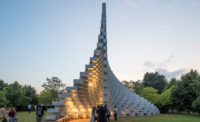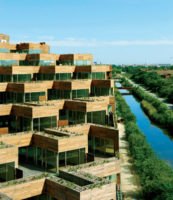UPDATED
Bjarke Ingels Group to Design 2016 Serpentine Pavilion
Four other architects will design summer houses to accompany BIG's structure on the gallery's lawn.

Image courtesy Bjarke Ingels Group

Image courtesy Bjarke Ingels Group

Image courtesy Bjarke Ingels Group

Image courtesy Bjarke Ingels Group

Image courtesy Bjarke Ingels Group

Images courtesy Bjarke Ingels Group






Architects & Firms
Fresh off a string of high-profile commissions, Danish architect Bjarke Ingels and his firm, BIG, have been selected to design the 2016 Serpentine Pavilion in London this summer. And, for the first time, four other architects—Kunlé Adeyemi/NLÉ, Barkow Leibinger, Yona Friedman, and Asif Khan—will each create a summer house to accompany it. (Read more on those four here.)
“We have studied the footsteps in which we follow,” says Ingels, whose ethereal plan evokes the airy framework of Sou Fujimoto’s 2013 pavilion.
The concept, based on the simple manipulation of a traditional garden wall, calls for a stack of extruded-fiberglass modules that seem to unzip toward the ground, forming a cavity to accommodate the gallery’s programs.
The design, the architect says, “embodies multiple aspects that are often perceived as opposites—free-form yet rigorous, modular yet sculptural, both transparent and opaque, both box and blob.”
For this year’s commission, timing was key. As a prerequisite, the chosen architect must have no built work in England, so for BIG, with a plaza in the works at London’s redeveloped Battersea Power Station, the eligibility window was narrowing.
The annual competition, established by the Serpentine Gallery’s co-director Julia Peyton-Jones in 2000, began with a tentlike structure by Zaha Hadid, and has since showcased work by top architects including Oscar Niemeyer (2003), Frank Gehry (2008), Jean Nouvel (2010), and, most recently, the Spanish firm SelgasCano. Peyton-Jones announced plans to step down after 25 years with the gallery, which could account for her wish to expand this year’s program.
“All projects have been thrilling to commission and will be equally exciting to realize,” said Peyton-Jones. “We cannot wait to unveil them all this summer.”
From one perspective, the pavilion’s profile is undulating and opaque; viewed from the other side, its silhouette appears rectangular and transparent. Inside, wood floors provide warm contrast to the fiberglass shell.
Bjarke Ingels founded his practice in 2005, with offices in Copenhagen and New York. Ingels recently revealed plans for the Spiral, a new tower alongside New York’s High Line.









